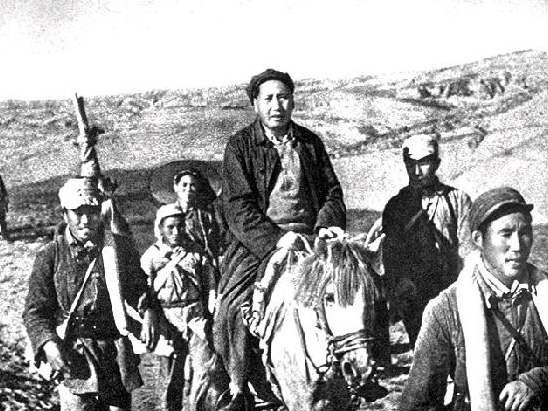From the years 1934-1957, Mao’s establishment of his personal control over the party and country developed from the Long March up until the Hundred Flowers Campaign. His personal control over the country then declined in the years following the Great Leap Forward but then increased upon the Cultural Revolution of 1976.
The Long March of 1934 increased Mao’s control over the CCP. This was significant as it allowed him along with 100,000 troops, to break out of Jiangxi which was now infested by the Guomindang and set up a base at Yanan. During the march, communist ideas were spread in new areas leading to an increase in support for the CCP. As well as this, it allowed Mao to emerge as the true leader of the CCP, dissolving the influence of Soviet Russia. Therefore the Long March showed a development in Mao establishing control in his party with him making it less international and more nationalistic, but showed little change in his control over the country as a whole.
The setting up of a communist base in Yanan from the success of the Long March, ultimately helped the CCP win the Civil War and contributed to a rapid development in his personal control of the country and also in the party leading up to the Hundred Flowers Campaign. The Hundred Flowers Campaign of 1957 initially decreased Mao’s personal control of both the party and the country with him facing heavy criticism from students, university lecturers, writers etc. However, he reasserted his control of the country with the anti-rightist movement by arresting the critics and sending bourgeois revolutionaries to labour camps to be re-educated. The Hundred Flowers Campaign further established Mao’s control of both the country and the party despite the criticism he initially faced.
However, he launched the Great Leap Forward that same year. Mao launched the campaign as a way of making China an industrial superpower. He did this through the setting up of communes, encouraging collectivisation and setting up the Backyard Blast Furnace Campaign. The Great Leap Forward was a failure for Mao as steel produced was of poor quality and as a result of forced collectivisation, crops were neglected which brought about famine and the deaths of 30 million Chinese. The Great Leap Forward of 1957 if anything, significantly weakened Mao’s control over the country with its complete failure but having said this, there was stasis in terms of his control over the party.
Consequently, Mao’s control over the country declined over the following years with him resigning as President in 1958. However his control over the party was very much the same with him still being Chairman of the CCP. The Cultural Revolution was Mao’s attempt of regaining his personal control not only over the party but in the country, with the years leading up to 1966 showing a regression in his authority in China. He gained the support of the 4 million strong PLA and set up the Red Guards who succeeded in attacking the four “olds”. The Cultural Revolution was a turning point in terms of Mao’s personal control as it brought him back into the light of the public and thus allowed him to reassert his control over China and get rid of the moderates Liu and Deng.
In conclusion, Mao’s personal control over the Party seems to progress throughout the years up to his resignation as President where it declines after; though he regains it upon the Cultural Revolution. However, his personal control on the country is not completely apparent until after the Civil War where it progresses up to 1957, faces regression in the years leading up to the Cultural Revolution, but again increases by 1966.

Definitely a 15/15 🙂
LikeLiked by 1 person